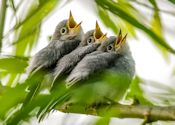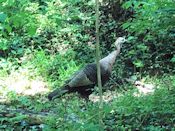FODMer Jane Gamble had two photographs in Virginia Wildlife magazine’s July/August 2020 annual photography showcase which highlighted images from 111 photographers. One photo was of three blue-gray gnatcatcher nestlings begging for food. The second was a white-tailed doe deer with her fawn. The magazine is published by the Virginia Department of Wildlife Resources. Congratulations, Jane.
News
FODMer Ed Eder snapped a photo of the newly-discovered comet, C/2020 NEOWISE on July 13 at 4:40 a.m. Ed was looking from Dyke Marsh north-northeast toward the middle of the Woodrow Wilson Bridge and up about 10 degrees. Ed suggests that after July 15, people should watch for it in the north-northwest sky at night about 80 minutes after sunset.
On June 26, 2020, four FODM volunteers and one Westgrove P.A.C.K. volunteer conducted habitat quality testing in an unnamed intermittent stream flowing through Mount Vernon Park into west Dyke Marsh. This effort was led by Dan Schwartz and Ashley Palmer of the Northern Virginia Soil and Water Conservation District (NVSWCD).
From 9:30 a.m. to 12 noon, the group took 20 samples from the stream within a 100-meter span, with the goal of identifying 100 living benthic macroinvertebrates. They found these species: 13 scuds, three trueflies, one aquatic worm and one “other.”
Visitors to Dyke Marsh will find a photography station called Chronolog on the Haul Road trail at the native plant site, DMW-101. Unfortunately, our second station on the boardwalk across from Tulane Drive, DMW-102, was destroyed twice. Neither FODM or the U. S. Park Police know why it was apparently vandalized. At this time, FODM will not replace it at that site
This station helps document and better visualize landscape changes over time in the preserve. Changes in a landscape can be slow to see, whether they are seasonal changes, results of the restoration project or longer-term changes.
Virginia U.S. Senator Mark Warner came to Belle Haven Park/Dyke Marsh on June 22, 2020 and championed the Senate’s June 19 approval of the Great American Outdoors Act. The bill would fully and permanently fund the Land and Water Conservation Fund (LWCF) at $900 million a year and allocate $9.5 billion to address the maintenance backlog on public lands, including national parks, refuges, U.S forests and other lands. The National Park Service has a $12 billion maintenance backlog; Virginia parks, $1.1 billion; the George Washington Memorial Parkway, $717 million.
In late May, several people observed a wild turkey (Meleagris gallopavo) on and near the Haul Road trail. Our FODM breeding bird survey leader Larry Cartwright reported on May 29, 2022, “A hen wild turkey strolled down the path near the Haul Road entrance. The turkey was icing on the cake.”
The next day, FODMer Ed Eder snapped a photo and speculated, “The well-fed turkey is probably consuming a lot of insects in the native planting area.” On May 30, 2022, Leila Saldanha took several photos of “our” turkey.







